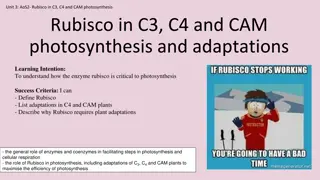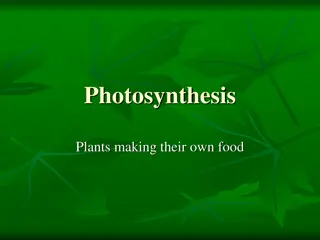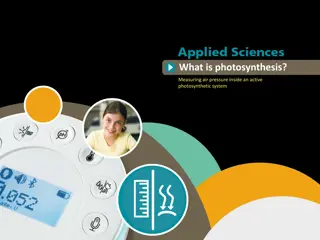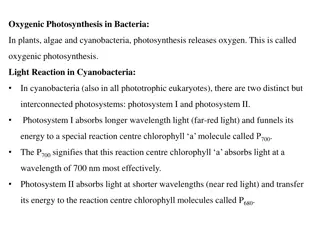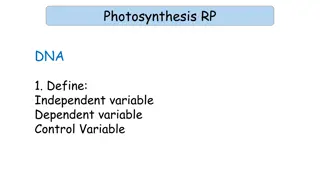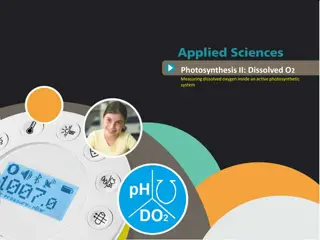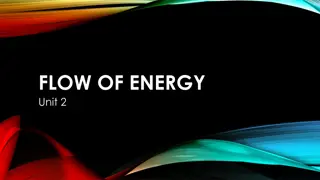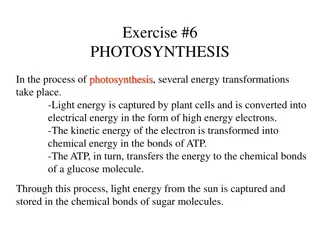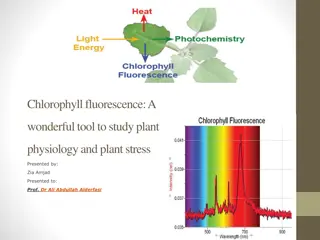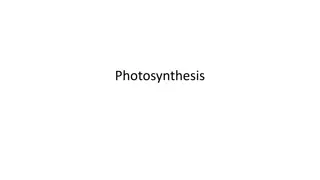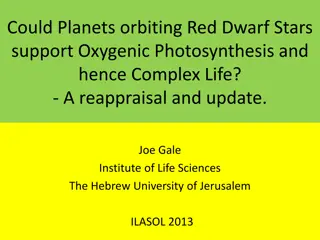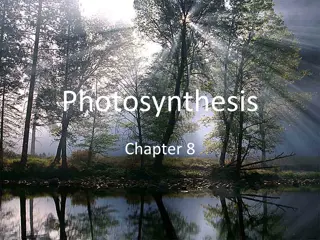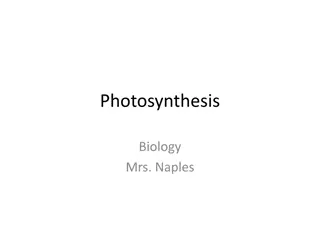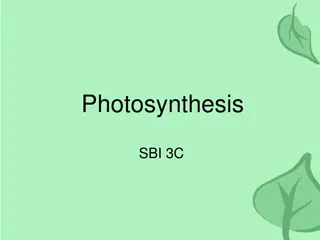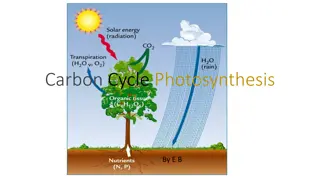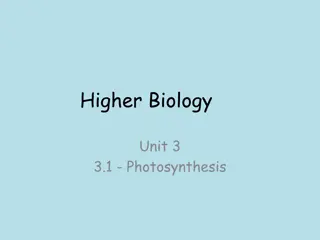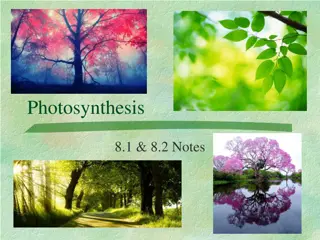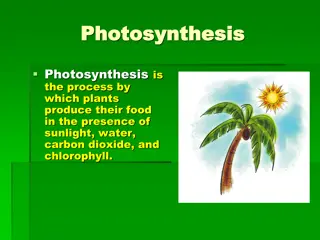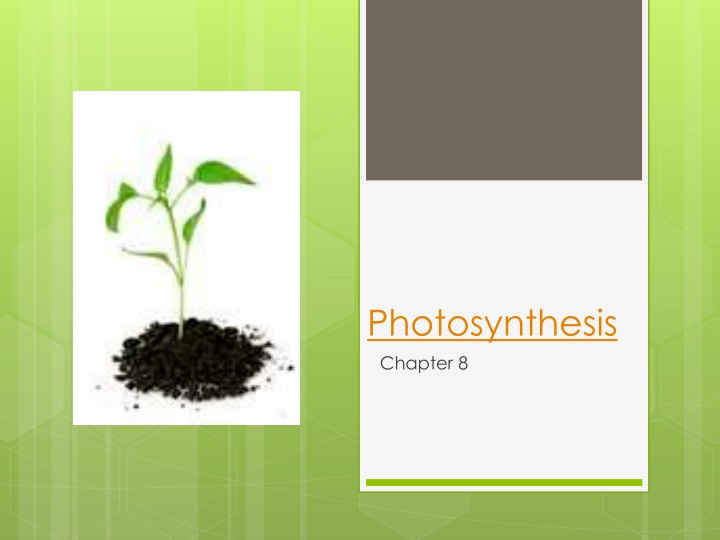
Insights into the Process of Photosynthesis and Its Discoveries
Discover the fascinating process of photosynthesis and the contributions of scientists such as Van Helmont, Joseph Priestley, and Ingen-Housz in understanding how plants convert light energy into chemical energy. Learn about the essential elements needed for plants to photosynthesize and how this process led to the discovery of how plants produce carbohydrates and release oxygen. Explore the experiments that paved the way for our current knowledge of photosynthesis.
Download Presentation

Please find below an Image/Link to download the presentation.
The content on the website is provided AS IS for your information and personal use only. It may not be sold, licensed, or shared on other websites without obtaining consent from the author. If you encounter any issues during the download, it is possible that the publisher has removed the file from their server.
You are allowed to download the files provided on this website for personal or commercial use, subject to the condition that they are used lawfully. All files are the property of their respective owners.
The content on the website is provided AS IS for your information and personal use only. It may not be sold, licensed, or shared on other websites without obtaining consent from the author.
E N D
Presentation Transcript
Photosynthesis Chapter 8
Where does all of our energy come from?
How do plants get food? Photosynthesis- Process by which green plants or organism with chlorophyll convert light energy into chemical energy in the bonds of carbohydrates Autotrophic Can transfer energy to produce food can synthesize food Heterotrophic Must obtain energy from preformed food gotta eat food!
What is needed for autotrophs to photosynthesize? Carbon dioxide (atmospheric) Water (in the soil or air) Sunlight (or artificial light source) Chlorophyll (present in leaves and sometimes stems) Enzymes (to regulate the rate of the reaction)
Who helped us figure this out? Van Helmont (1600s) experiment with potted plant to determine what a plant uses to grow.
Conclusion: mass of tree comes from water He got it only half right: there is also CO2!
Who helped us figure this out? Joseph Priestly (1770s) experiment with candle, sprig of mint and a jar
Who helped us figure this out? Ingen-Housz repeated Priestley s experiment but put the sprig of mint in the dark Candle would not burn for as long in the dark, so LIGHT is important for plants
Putting it all together The experiments performed by van Helmont, Priestley, and Ingenhousz led to work by other scientists who finally discovered that in the presence of light, plants transform carbon dioxide and water into carbohydrates, and they also release oxygen
THE FORMULA chlorophyll CO2 + 6H20 + light C6H12O6 enzymes Seems simple, huh? Takes EIGHTY different chemical reactions from start to finish
Where does Photosynthesis happen? In the chloroplasts! Chloroplasts are oval structure consisting of stacks called grana (photosynthetic membranes) and a liquid called stroma. Chlorophyll is found in the stacked grana
What are the pigments Two main ones Chlorophyll a and Chlorophyll b Other accessory pigments Absorb other wavelengths of light Carotenoids, xylophylls, anthocyanin
Light White light is a mixture of all the wavelengths of visible light Color is all about the reflection of light
Absorption and Reflection Chlorophyll absorbs red/blue light the best It mostly reflects green light THIS IS WHY PLANTS ARE GREEN!
Why do the leaves change? When [water] is low, plant pigments break down Mostly green pigment, that goes away first
ATP When chlorophyll absorbs light, it is absorbing energy It stores it in the bonds of Adenosine Triphosphate (ATP)
ATP ATP Made of Adenine (nitrogenous base) Ribose (5 carbon sugar) 3 phosphate groups This is temporary storage ADP AMP
ATP Is constantly made and broken down Think of ATP like cash in your pocket Glucose like an ATM card Glycogen like your savings account Lipids like a Savings Bond
2 Main steps of PS 1. Light reactions occurs only in the presence of light Occurs in the grana (thylakoids) of the chloroplasts Also known as Photolysis because light is used to split water molecules into hydrogen and oxygen
2 Main steps of PS 1. Dark Reactions can occur in light or darkness. Follows light reactions Occurs in the stroma of the chloroplasts Also known as Carbon fixation because CO2will get fixed up with the hydrogens and energy from the light reaction
Light Reactions The light energy strikes the leaf, passes into the leaf and hits a chloroplast inside an individual cell. The light energy, upon entering the chloroplasts, is captured by the chlorophyll inside a granum. Inside the grana some of the energy is used to split water into hydrogen and oxygen. The oxygen is released into the air. 1. 2. 3. 4.
Light-dependent reactions IN THE THYLAKOID MEMBRANE 1. Light energy excites chlorophyll s electrons in Photosystem II. 2. The high-energy electrons are passed along to the Electron Transport Chain, then Photosystem I. 3. Water is broken into 2 electrons, 2 H+ ions, and 1 oxygen atom. This is the part of the equation where water is used and oxygen is created! 6CO + 6H2O ------ C6H12O6 + O2 The electrons replace those lost by chlorophyll, the oxygen is stored until it is released, and the H+ ions are pumped from the stroma into the inner thylakoid space.
4. In Photosystem I, the high energy electrons are used to add H+ ions to the molecule NADP+, creating NADPH (which is now storing the energy of those electrons). 5. Finally, all of the H+ ions in the inner thylakoid space start to diffuse out through a carrier protein known as ATP synthase. As they pass through, their energy is used to add a phosphate to ADP, creating ATP.
Review of Light-Dependent reactions in the photosystems of the thylakoid membrane: Reactants light energy, water Products NADPH, ATP (both energy carriers), Oxygen (given off) Light energy has now been captured in chemical bonds.
The Dark Reactions The hydrogen is taken to the stroma along with the grana's remaining light energy. Carbon dioxide enters the leaf and passes into the chloroplast. In the stroma the remaining light energy is used to combine hydrogen and carbon dioxide to make carbohydrates. This occurs during the Calvin Cycle The energy-rich carbohydrates are carried to the plant's cells. The energy-rich carbohydrates are used by the cells to drive the plant's life processes. 5. 6. 7. 8. 9.
Light-dependent reactions IN THE THYLAKOID MEMBRANE 1. Light energy excites chlorophyll s electrons in Photosystem II. 2. The high-energy electrons are passed along to the Electron Transport Chain, then Photosystem I. 3. Water is broken into 2 electrons, 2 H+ ions, and 1 oxygen atom. This is the part of the equation where water is used and oxygen is created! 6CO + 6H2O ------ C6H12O6 + O2 The electrons replace those lost by chlorophyll, the oxygen is stored until it is released, and the H+ ions are pumped from the stroma into the inner thylakoid space.
4. In Photosystem I, the high energy electrons are used to add H+ ions to the molecule NADP+, creating NADPH (which is now storing the energy of those electrons). 5. Finally, all of the H+ ions in the inner thylakoid space start to diffuse out through a carrier protein known as ATP synthase. As they pass through, their energy is used to add a phosphate to ADP, creating ATP.
Review of Light-Dependent reactions in the photosystems of the thylakoid membrane: Reactants light energy, water Products NADPH, ATP (both energy carriers), Oxygen (given off) Light energy has now been captured in chemical bonds.


